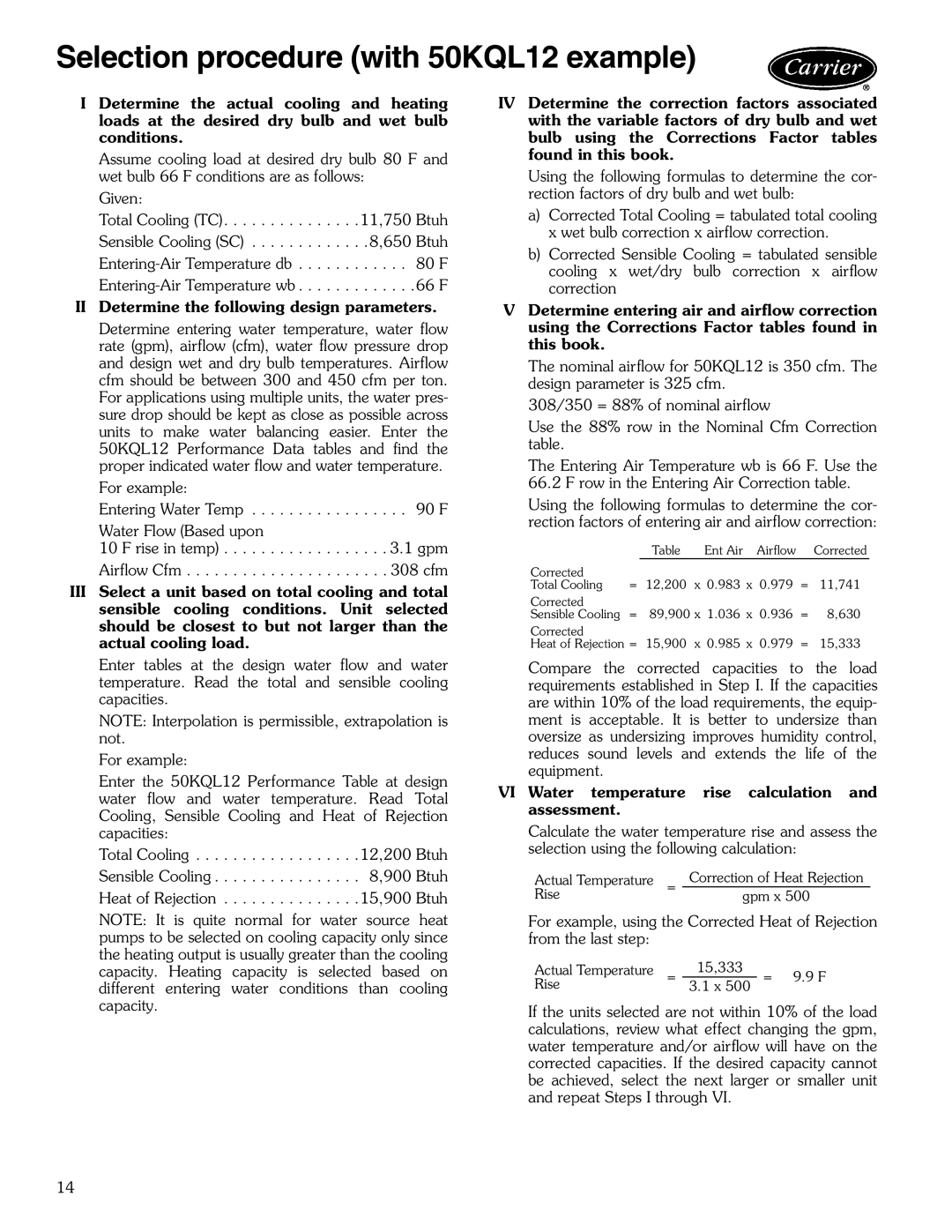Selection procedure (with 50KQL12 example)
I Determine the actual cooling and heating loads at the desired dry bulb and wet bulb conditions.
Assume cooling load at desired dry bulb 80 F and wet bulb 66 F conditions are as follows:
Given:
Total Cooling (TC). . . . . . . . . . . . . . .11,750 Btuh Sensible Cooling (SC) . . . . . . . . . . . . .8,650 Btuh
IIDetermine the following design parameters.
Determine entering water temperature, water flow rate (gpm), airflow (cfm), water flow pressure drop and design wet and dry bulb temperatures. Airflow cfm should be between 300 and 450 cfm per ton. For applications using multiple units, the water pres- sure drop should be kept as close as possible across units to make water balancing easier. Enter the 50KQL12 Performance Data tables and find the proper indicated water flow and water temperature.
For example:
Entering Water Temp . . . . . . . . . . . . . . . . . 90 F
Water Flow (Based upon
10 F rise in temp) . . . . . . . . . . . . . . . . . . 3.1 gpm Airflow Cfm . . . . . . . . . . . . . . . . . . . . . . 308 cfm
IIISelect a unit based on total cooling and total sensible cooling conditions. Unit selected should be closest to but not larger than the actual cooling load.
Enter tables at the design water flow and water temperature. Read the total and sensible cooling capacities.
NOTE: Interpolation is permissible, extrapolation is not.
For example:
Enter the 50KQL12 Performance Table at design water flow and water temperature. Read Total Cooling, Sensible Cooling and Heat of Rejection capacities:
Total Cooling . . . . . . . . . . . . . . . . . .12,200 Btuh Sensible Cooling . . . . . . . . . . . . . . . . 8,900 Btuh Heat of Rejection . . . . . . . . . . . . . . .15,900 Btuh
NOTE: It is quite normal for water source heat pumps to be selected on cooling capacity only since the heating output is usually greater than the cooling capacity. Heating capacity is selected based on different entering water conditions than cooling capacity.
IV Determine the correction factors associated with the variable factors of dry bulb and wet bulb using the Corrections Factor tables found in this book.
Using the following formulas to determine the cor- rection factors of dry bulb and wet bulb:
a)Corrected Total Cooling = tabulated total cooling x wet bulb correction x airflow correction.
b)Corrected Sensible Cooling = tabulated sensible cooling x wet/dry bulb correction x airflow correction
VDetermine entering air and airflow correction using the Corrections Factor tables found in this book.
The nominal airflow for 50KQL12 is 350 cfm. The design parameter is 325 cfm.
308/350 = 88% of nominal airflow
Use the 88% row in the Nominal Cfm Correction table.
The Entering Air Temperature wb is 66 F. Use the 66.2 F row in the Entering Air Correction table.
Using the following formulas to determine the cor- rection factors of entering air and airflow correction:
|
| Table | Ent Air | Airflow |
| Corrected |
Corrected |
|
|
|
|
|
|
Total Cooling | = | 12,200 | x 0.983 | x 0.979 | = | 11,741 |
Corrected |
|
|
|
|
|
|
Sensible Cooling | = | 89,900 x 1.036 | x 0.936 | = | 8,630 | |
Corrected |
|
|
|
|
|
|
Heat of Rejection = | 15,900 | x 0.985 | x 0.979 | = | 15,333 | |
Compare the corrected capacities to the load requirements established in Step I. If the capacities are within 10% of the load requirements, the equip- ment is acceptable. It is better to undersize than oversize as undersizing improves humidity control, reduces sound levels and extends the life of the equipment.
VI Water temperature rise calculation and assessment.
Calculate the water temperature rise and assess the selection using the following calculation:
Actual Temperature | = | Correction of Heat Rejection |
Rise |
| gpm x 500 |
For example, using the Corrected Heat of Rejection from the last step:
Actual Temperature | = | 15,333 | = 9.9 F |
Rise |
| 3.1 x 500 |
|
If the units selected are not within 10% of the load calculations, review what effect changing the gpm, water temperature and/or airflow will have on the corrected capacities. If the desired capacity cannot be achieved, select the next larger or smaller unit and repeat Steps I through VI.
14
